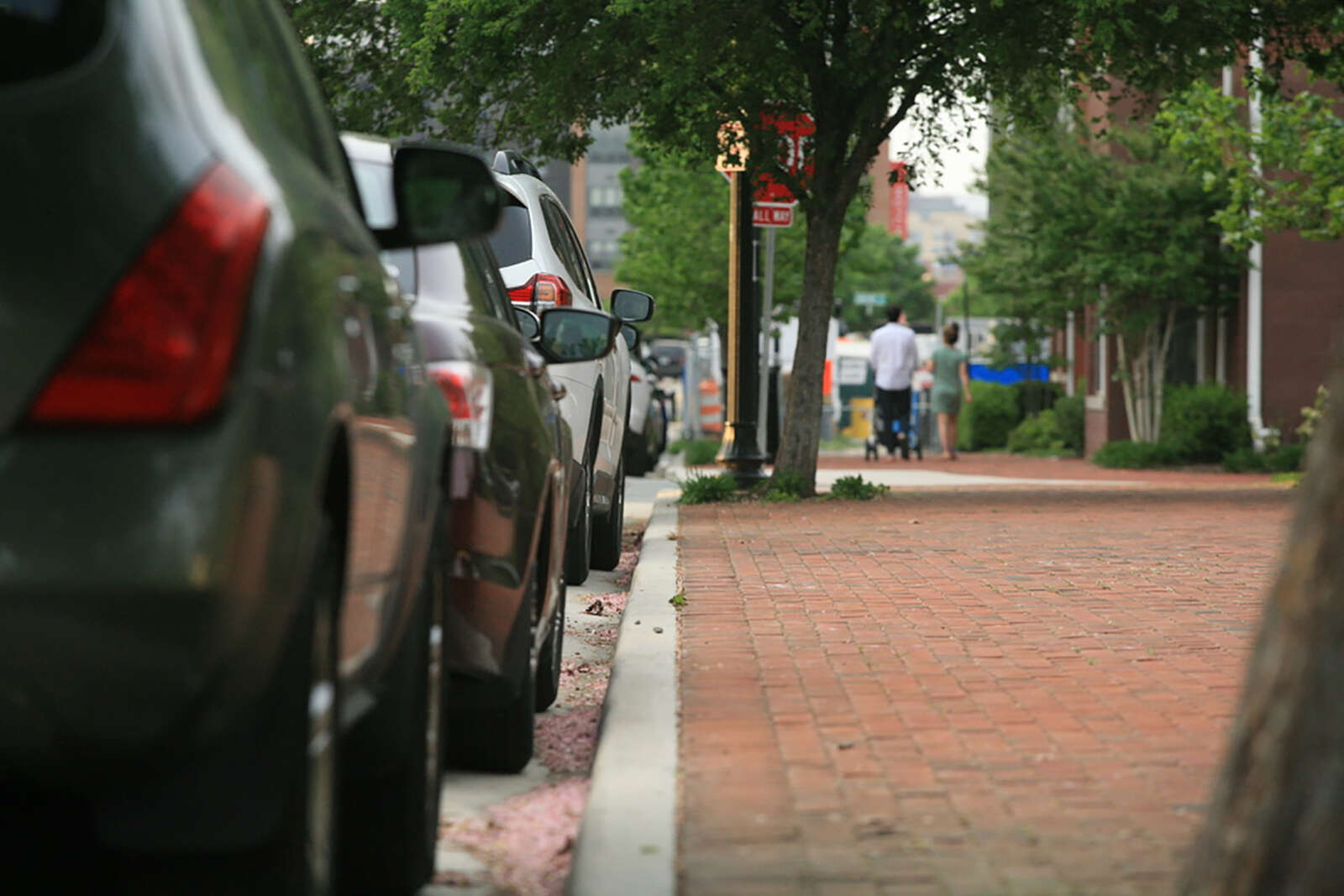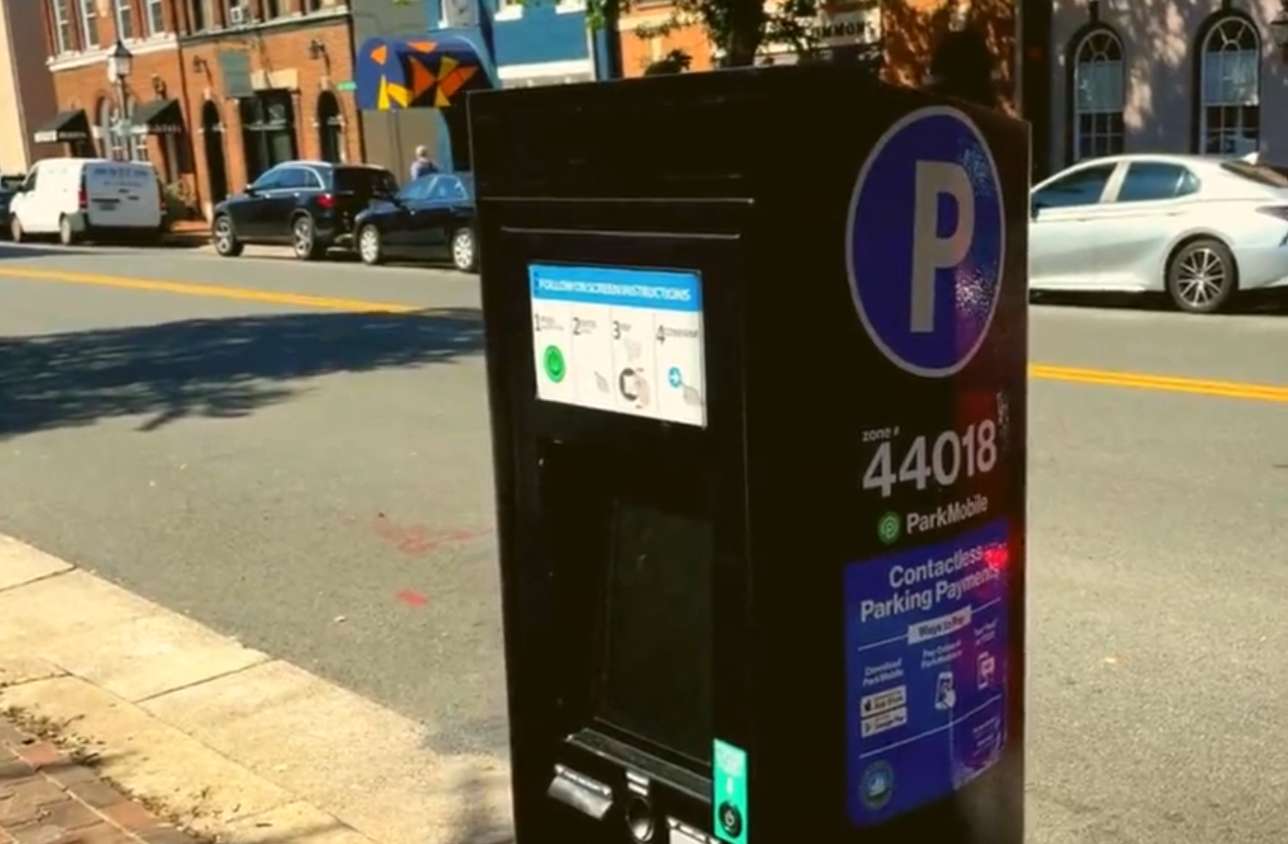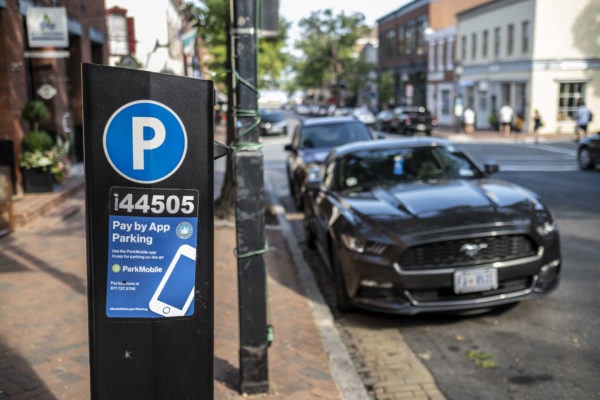
A new pilot program to step up parking enforcement in Old Town netted 4,000 citations in its first month.
A staff memo (page 8) to the Traffic and Parking Board said that over half of the 4,000 parking citations issued through the pilot with contractor Reimagine Parking were for parking meter violations.
The program started on Dec. 27. It primarily focused on enforcement along King Street from 7 a.m.-11 p.m. Monday-Firday.
According to the memo:
The parking enforcement pilot supplements the City’s existing parking enforcement officers and provides parking enforcement in Old Town, primarily along and around King Street. The contractors are authorized to issue citations only and do not handle issues of towing, vehicle relocation, or booting. The parking enforcement contractors wear identifiable reflective vests with parking enforcement written on them as can be seen in the photo below.
Alexandria City Council Member John Taylor Chapman wants to pursue making the 200 block of King Street into a pedestrian zone, and employees managing many of the businesses on that block have mixed feelings.
The move would mean having a pedestrian-only zone next door to City Hall’s Market Square (301 King Street) going all the way down to the waterfront.
Chapman told ALXnow that his plan is in its infancy, but that he will ask city staff about the feasibility of extending the pedestrian area that was permanently approved for the unit and 100 blocks of King Street in late 2022. The City closed the 100 block of King Street to car traffic in 2020 to help small businesses with outdoor seating during the pandemic, and the unit blocks of King Street and Strand Street were later added to the pilot.
Chapman is running for reelection and lists creating more pedestrian-only areas in his campaign platform.
“We’ve done the zero block and the 100 block (of King Street), and the 200 block is the next step,” Chapman told ALXnow. “Now I’m talking to those retailers to see if I can get their buy-in.”
Nearly half of the street parking on the eastern portion of the 200 block is taken up by a parklet rented for outdoor dining by The Warehouse restaurant at 214 King Street.
Ethan Wagner, manager of Old Virginia Tobacco (210 King Street), says a pedestrian zone will be a burden on his customers. He also said that the 200 block was shut down during the recent Scottish Christmas Walk Parade on Dec. 2, and that his employees had a hard time finding parking for work.
“There’s at least 15-to-20 parking spots right outside,” Wagner said. “I like the idea in theory, but I’m not a big fan of it because of the parking.”
Jaylen Walker, manager of Kilwins Chocolates and Ice Cream (212 King Street), said that the closure could be an issue for handicapped customers who need to be transported near the front door of the business.
“There’s a lot of parking garages nearby, and realistically, people are already down here to begin with,” he said. “The handicap issue is my only thing.”
A survey of community feedback on the closure of the unit and 100 blocks found that 91% (of 1,853 survey respondents) rated the pedestrian zone as very positive.
The city’s transportation division chief, however, said last year that extending the pedestrian zone to the 200 block could be problematic, as it has fewer restaurants that lend themselves to outdoor seating.
Clint Mansell, manager of the Principle Gallery (208 King Street), said that customers and clients like dropping off their art by parking directly in front of the gallery.
“There’s more retail and fewer restaurants on this block,” Mansell said. “There’s a European feeling to it, the walkability. I have mixed feelings. It would be nice to have some time to think about this.”
Todd Lippert, the longtime assistant manager at Comfort One Shoes (201 King Street), is all in favor of the idea.
“I think it’s wonderful,” Lippert said. It’s about time that people in Old Town forget their cars and begin to walk, enjoy their lives, enjoy their shoes and enjoy their walks.”

The impact that the proposed Washington Wizards/Capitals arena at Potomac Yard will have on local businesses will be discussed in a virtual town hall meeting this week.
Stephanie Landrum, CEO of the Alexandria Economic Development Partnership (AEDP), will speak about the ramifications in a Zoom meeting at noon on Thursday (Jan. 21).
Reception of the news that the multi-billion dollar arena and entertainment district is coming to Potomac Yard has been tepid at best. While an AEDP report states that the development will result in 30,000 new jobs, the city is contending with a number of challenges before the deal can be sealed.
Last week, a group of residents from the Coalition to Stop the Arena at Potomac Yard rallied in protest outside the Potomac Yard Metro station — next door to the proposed development. Concerns ranged from the project’s transportation and financial impacts to parking and quality of life.
“An entertainment district is projected to generate roughly 2.5 times the economic output of what would otherwise be built based on current development plans,” according to an AEDP impact analysis.
Metro General Manager Randy Clarke also said that the newly opened Potomac Yard Metro station can’t handle arena-size crowds and will need an upgrade. In an effort to encourage alternative transportation to events at the proposed district, Mayor Justin Wilson says there will be minimal parking at the completed site, prompting some concern that neighboring communities will be affected by spillover parking.
Landrum recently said that the fate of the Target store at 3101 Richmond Highway in Potomac Yard is undetermined, but that it is one of the most frequent questions she gets regarding the development.
In-home childcare providers have, for years, faced a problem: many of them work in residential neighborhoods requiring Residential Parking Permits, leaving them with no good options for parking.
A zoning change working through city bureaucracy could make it easier for in-home childcare workers to secure parking in residential neighborhoods.
Mayor Justin Wilson said in a monthly newsletter that there are currently no good parking options for in-home childcare workers.
“For the parents who live in these districts and have in-home childcare, they are left with a few bad options, including disingenuous practices, leaving children unsupervised to rotate vehicles, etc.,” Wilson wrote. “The City Code creates an inequity between home healthcare workers and childcare workers which cannot be justified.”
Wilson said that the Residential Parking Permit program started in 1979. Back in 2005, then-City Manager James Hartmann put forward an ordinance that would allow issuance of residential parking permits for use by daycare and health care workers providing those services at residences in permit parking districts.
The City Council approved a pilot for home healthcare workers, but Wilson said the Council rejected the childcare proposal. The issue came up again briefly in 2008 but nothing changed.
“As such, last month I proposed to the City Council that we rectify this challenge by allowing childcare workers, serving families in a residential parking permit district, to access these permits, Wilson wrote. “With the support of my colleagues, this proposal will now return to the Traffic & Parking Board and eventually City Council for formal consideration this fall.”
New parking meters are being installed in Alexandria to ditch the old pay-and-display system.
Earlier this year, the city started moving away from pay and display systems with new pay-by-plate meters installed in the Carlyle and Potomac Yard neighborhoods. But now, those meters are starting to get a citywide expansion to replace the older systems.
Users can either use the parking app ParkMobile or input their license place information into the kiosk directly.
“New parking meters are coming to Alexandria early fall 2023,” the city’s website said. “Simply enter your license plate number and pay using the kiosk or ParkMobile app.”
Parking in Alexandria just got easier! New parking meters are being installed that no longer require you to pay and display the receipt on your windshield. Have you seen these new meters around town?
Learn more about parking in Alexandria >>https://t.co/ILmigtOKZ3 pic.twitter.com/gvEVOYqmqs
— Alexandria Transportation & Environmental Services (@AlexandriaVATES) September 21, 2023
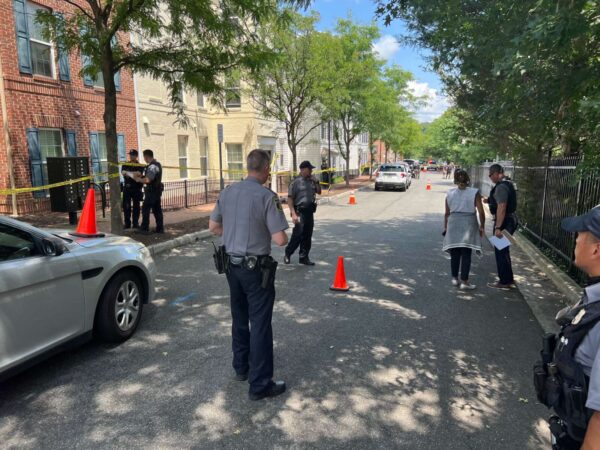
It’s been a scorching week in Alexandria, punctuated by two major crime events.
Someone was shot multiple times in an alley several blocks east of the Braddock Metro station last Saturday, followed on Monday afternoon by the city’s fifth homicide this year — the fatal shooting of a 29-year-old man on W. Glebe Road in Arlandria.
It is not believed that the incidents are connected.
The Alexandria Police Department is now looking for a silver Nissan Rogue allegedly linked to Monday’s shooting.
No arrests have been announced from either incident, and this week Mayor Justin Wilson, City Manager Jim Parajon and Police Chief Don Hayes asked for the community’s help in identifying the suspects.
Top stories this week:
- Alexandria ditching ‘pay and display’ parking meters citywide (32618 views)
- Notes: Many federal employees who report to work Alexandria are still mostly remote (7448 views)
- Del Ray Gateway project construction to start before end of year, city says (6510 views)
- Construction suspended for Holiday Inn Express at former Towne Motel site in Old Town North (5346 views)
- ACPS ignores Gov. Youngkin’s recommended policies on treatment of transgender students (4829 views)
- DEVELOPING: Man transported to hospital in critical condition after shooting in Arlandria (4747 views)
- Pupatella Neapolitan Pizza opening before end of year in Old Town North, owner says (3857 views)
- Duke Street affordable apartment complex ‘Witter Place’ could be ready by late 2025, developer says (3598 views)
- Arlington man busted for allegedly selling stolen car to Alexandria man on Facebook Marketplace (2509 views)
Have a safe weekend!
Alexandria’s garages aren’t the only parking tool getting an overhaul.
A report for a meeting of the Traffic and Parking Board later today (Monday) said the city is working through a replacement of the city’s parking meters.
The city is ditching the “pay and display” model of parking meters — meters where drivers leave the ticket on the dashboard — and switching over to a system that keeps track of who has paid for parking by license plates.
“The City is replacing and upgrading parking meters from pay and display to by plate citywide,” the report said. “The meters that are pay and display print out a ticket that is then displayed inside the car by the user.”
The report said there are currently pay-by-plate meters in Carlyle and Potomac Yard, but that’s being expanded across the city starting with meters that were installed over 13 years ago and have reached the end of their useful life.
“There are currently pay by plate meters in Carlyle and Potomac Yard where the user puts their license plate number into the meter while paying and no ticket is needed,” the report said. “The upgrade of the meters to pay by plate involves replacing parking meters that have reached the end of their useful life and upgrading other meters to the newer pay by plate technology.”
The overhaul is also reducing the number of meters from four on each block to two — one on each side of the street where applicable. The report said the goal is to cut down on the sidewalk clutter, with most parking meters made obsolete by apps like ParkMobile.
“In recent years, there has been a large adoption of people paying for parking on their phones via ParkMobile instead of at the physical meter,” the report said. “We anticipate the use of paying via phone will continue to increase in the coming years. This supports the move to consolidated meters leading to less clutter on the sidewalks.”
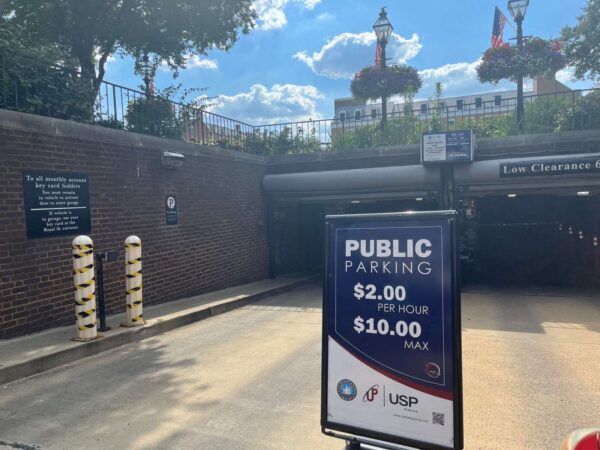
Ever pulled into one of Old Town’s parking garages and been frustrated to find a sign saying the garage is full — or, worse, driven circles around the garage looking for a spot only to realize it’s full?
A solution could be on the way. A series of applications to the Board of Architectural Review for the Wednesday, July 19 meeting, indicate the city is looking at installing real-time parking availability signs.
According to the application:
The digital display will indicate real-time space availability in the parking lot. By doing so, these signs will help meet the Alexandria Mobility Plan (AMP) Curb Space and Parking
strategy by guiding users to off-street parking. This improved information will decrease driving around hunting for parking and therefore decrease traffic and pollution. Due to electrical wiring issues, instead of installing the sign in the same location as the present sign, the new sign will be installed at the southeast corner of the planting bed adjacent to the north side of the garage entrance. Staff finds the design and the lighting appropriate for this property and recommends approval of the project as submitted.
The applications are for garages at Market Square (108 N. Fairfax Street), Courthouse Square (111 S. Pitt Street), and just across from the Torpedo Factory (220 N. Union Street).
The changes are part of an overhaul that aims to get more visitors to Old Town in parking garages and off the streets. Last year, the City Council authorized changes that made garages cheaper than street parking.
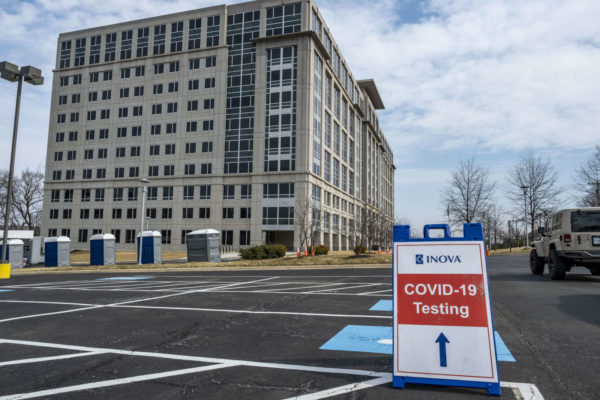
This week in Alexandria, some long-planned changes around town started to take shape.
The biggest is that the Victory Center’s days may well be numbered, with developer Stonebridge and city staff currently in back-and-forth discussions over whether the building should be entirely demolished or not.
Just today, the city announced the pricing structure planned for pay-by-phone parking in Old Town, meaning street parking could soon become more expensive while garages will get cheaper.
Top stories
- Stonebridge submits plans for Victory Center demolition and redevelopment
- Suspects chased by police, ditch stolen car in Old Town
- Alexandria rolls out speed camera plans ahead of implementation next year
- Spicy chicken chain Hangry Joe’s opens in Alexandria Commons
- No arrests after commercial robbery across street from City Hall in Old Town
- Two more Covid deaths in Alexandria, cases surpass 40,000
- What is cut-through traffic and how does your phone help Alexandria track it?
- Alexandria rolls out new design for bus stops
- These restaurants, salons and other businesses are for sale in Alexandria
- The Torpedo Factory Art Center needs volunteers, and so do a lot of organizations in Alexandria
Two months after the City Council authorized changes to what Alexandrians pay to park in Old Town, city staff have come back with new price points for parking.
The aim of the change is to make parking in garages more appealing. Currently, many Old Town garages sit empty while drivers circle blocks looking for on-street parking.
“One change was to allow these blocks to have higher rates than the meter blocks,” Katye North, division chief for mobility services said in an email. “We’ve identified blocks that seem to have higher numbers of paid parking transactions, meaning there are more non-residents paying to park on these blocks than other residential pay by phone blocks.”
North said the price of parking on those blocks will nearly double.
“To encourage people to park elsewhere, we’ll be increasing the hourly parking rate from $1.75 (current meter rate) to $3,” North said. “The hours of restrictions and the two hour time limit remain unchanged and guests can still park for free if they have a guest permit.”
The second part of the change is incentivizing garage parking.
“In coordination with this increase, we are also reducing the hourly rate at the Courthouse Garage on nights and weekends to $1/hour (currently $2.50/hour),” North said. “We are hoping these changes will encourage people to use the cheaper off-street parking. Over the next few months, we’ll continue to monitor the data for these blocks and the garage to see if it’s making an impact and adjust as needed.”


